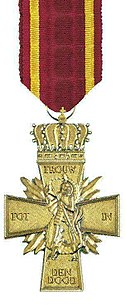| Dutch Cross of Resistance | |
|---|---|
 The Dutch Cross of Resistance | |
|
Awarded by | |
| Type | Civil decoration |
| Awarded for | For extreme bravery awarded to the Dutch Resistance |
| Status | Not awarded anymore |
| Statistics | |
| Established | 3 May 1946 |
| Total awarded | 95 times |
| Posthumous awards | 93 times |
| Distinct recipients | Gerard Tieman (only living recipient) |
| Precedence | |
| Next (higher) | Honorary Sabre |
| Next (lower) | Honorary Medal for Charitable Assistance |
|
Ribbon bar of the Dutch Cross of Resistance | |
The Verzetskruis 1940–1945 (English: Cross of Resistance 1940–1945) is the second highest decoration for valour in the Netherlands.
When the whole of the Netherlands was liberated in May 1945, the Dutch government in London already had a good and balanced system of both military and civilian honours. Besides the existing Military William Order new decorations had been introduced, like the Bronze Lion, the Bronze Cross, the Cross of Merit and the Airman's Cross. There was no decoration for Dutch resistance fighters, however. The Dutch government tried to introduce such an honour, following the examples by neighbouring countries, but for many months no agreement could be found to either award one of the existing Military decorations or create a civilian one.
Within the Dutch resistance there was a forceful movement against decoration of acts of resistance. They considered that every act of resistance, being equally dangerous under German occupation, was of equal merit. Other countries did decorate Dutch resistance people. A significant number of Dutch people were awarded decorations like the British King's Medal for Courage in the Cause of Freedom and the American Medal of Freedom for their resistance work. Queen Wilhelmina's wish for resistance workers to be decorated added pressure on the Dutch government to take action.
By Royal Decree of 3 May 1946 the Resistance Cross was created. The medal, designed by L. O. Wenckebach, is a Latin cross of bronze, crowned with the Dutch royal crown. The cross shows Saint George impaling a fire-breathing dragon, the latter representing Nazi Germany. The obverse shows a flaming sword and two broken chains. The words TROUW TOT IN DEN DOOD (loyal to death) are engraved in the arms of the cross.
The decoration was awarded only 95 times, to the bravest of the resistance, and by design posthumously. Only one living person was awarded the Verzetskuis, Gerard Tieman (born Amsterdam, 1 maart 1926). Most were awarded to Dutch, but some French and Belgians were honoured with the Cross of Resistance. One was awarded to the unknown Jewish soldier who gave his life in the Warsaw Ghetto for the liberty of all peoples.
See also
- Military William Order
- Order of the Netherlands Lion
- Order of Orange Nassau
The original article can be found at Dutch Cross of Resistance and the edit history here.